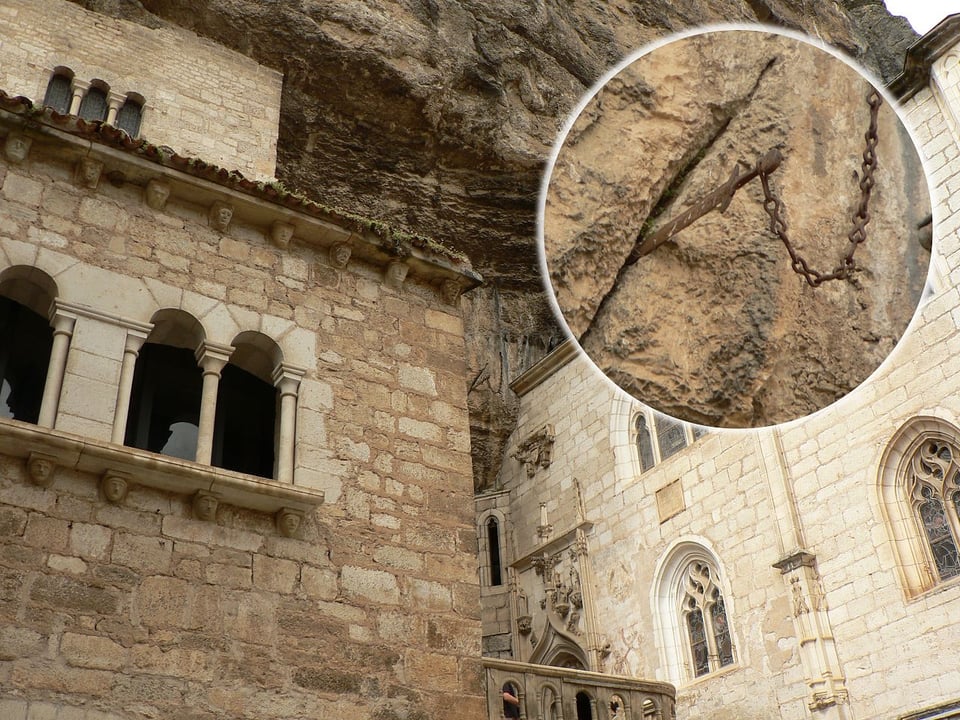Roland's Sword: Nostalgia, Tourism, Epic Poetry
A disappearing sword and some tall tales

Modern Medieval
by David M. Perry and Matthew Gabriele
The sword protruded from the cliff wall, high above the village of Rocamadour in southern France — flung there, according to local legend, by the great Carolingian warrior-hero Roland just before his death. And there the famous sword called “Durendal” hung, impaled in the rock, for over 1200 years, until in late June 2024 when it mysteriously vanished.
Spoiler: This, of course, didn’t happen. Swords don’t fly hundreds of miles, veering merrily around the mountaintops, even when flung by dying heroes. It wasn’t Roland’s sword or likely anything medieval at all, because the sword was placed in the rock during the 18th century as a tourist trap.
But what makes the story so interesting to us is that that there are three layers of mythmaking here: There was an 8th-century campaign in which Charlemagne’s rear-guard got ambushed. That military adventure got retold in the late 11th century (layer #1) epic poem entitled The Song of Roland. Then there was an 18th century noble just before the French Revolution (layer #2) who, along with some local clerics, decided to promote an old sword as Durendal as a way of attracting attention to their local community. And now, with the disappearance of this object and the international news headlines about the heist, we’re into layer #3. This very recent layer is both how the European Middle Ages figure into contemporary French politics and how too often media coverage of medieval history relies on simplistic stories.
Let’s gets started.

The Song of Roland is one of the best-known epic poems from the European Middle Ages (up there with Beowulf and El Cid and perhaps a few others). It describes a great campaign against the Islamic rulers of Iberia by the Emperor Charlemagne. Roland, the emperor’s nephew and greatest hero, is ambushed (due to treachery by another Frank) while leading the rear guard. Instead of calling for help right away, he fights and dies heroically but notifies his king of the treachery just before his death. Charlemagne charges back into Iberia to finish off the Muslims, aided by God and the angels. The Christian traitor is tried by combat and then ripped apart by horses. The poem ends with Charlemagne, wearily, yearning for rest, only for him to be called to save Christendom yet again.
Because it’s a legend of Charlemagne (ask Matt about legends of Charlemagne!), in Oathbreakers (our forthcoming book! Preorders are open!) we talk about what Roland reveals about tensions within the court and ideas about the proper role of the king.
But we also write that the actual 8th-century campaign in Iberia wasn’t a holy war; while there was an ambush, it wasn’t by Muslims. From the book:
“In the reality that spawned the much later fiction, Charlemagne had been invited into Iberia by the Islamic ruler of Barcelona, who needed help against other Islamic rivals in the region. There the Frankish army muddled around for a bit, won a few small victories in support of their Islamic allies, and then headed back north. But on the way back across the Pyrenees and into Francia, Charlemagne’s rear guard was attacked and defeated by local forces -- Christian Basques objecting to being invaded from the north. The Basques used their local knowledge to strike effectively at the tail end of the much larger Carolingian army, and succeeded in killing a number of prominent Frankish nobles.
But in the retelling from centuries later, Charlemagne and the Franks are in Iberia for conquest and conversion and the battle lines have been drawn more starkly. Gone are the real, historical, complicated politics that saw shifting alliances of Christians and Muslims. In its place, a holy war. Now, the Franks’ enemies have been transformed from Christian Basques to a unified force of Muslims from Iberia, North Africa, and as far away as Baghdad. As such, the legendary Charlemagne of the Roland poem stands very clearly at the head of all Christendom, God’s champion on earth.”
We don’t talk about Roland’s fancy sword, but it is a main character in the epic poem itself, especially at the end when Roland realizes that he’s dying. He spends a few verses praising his sword and touting all the victories he’s won, saying for example “so many vast lands I've brought to heel / That are now held by hoary-bearded Charles! / May no man own you who would flee in fight!” (you can see the whole section here: Owen, 1990). So he smashes the sword on the rock a few times, fails to break it, once again touts the vast territories he’s helped the emperor conquer (Anjou, Brittany, Poitou, Maine, Normandy, Romagna, Lombardy, Flanders, Bavaria, Burgundy, Saxony — all of which the Franks did conquer more or less - and then Apulia, Constantinople, Scotland, Ireland, and England — which they did not). He tries to break the sword yet again, can’t, gives up, and dies lying on top of it.
So much for Roland.
There are lots of medieval legends about Roland, because every work like the great epic comes out of some kind of tradition and sparks endless iterations of retellings, adaptions, and what we might call fanfic (complimentary!). We’re not aware of a story in which the sword miraculously travels to a small Occitanian cliffside, but it certainly wouldn’t have been out of bounds for medieval clerics to invent such a tale.

Still, nobody, including the locals, thinks this old blade is actually Roland’s, or even medieval. There’s some attempt by locals to say this is a copy of Roland’s sword. Or as the mayor told the New York Times, a “copy of a copy of a copy.” That preserves a strand of authenticity as a claim without having to actually verify anything by, say, carbon dating the sword.
Here’s what we know, based on Richard Barber, an English historian who focused on chivalric legends (especially Arthur), who wrote:
Durendal again heads the list when we come to ‘surviving’ swords. Tourists can see it fixed in the cliff face above the doorway to the shrine of the Virgin at Rocamadour; but this is a relatively modern feature and the sword is a nondescript nineteenth-century decorative sword of poor workmanship. In 1787 or 1788, a local lord, the Vicomte d’Anterroches, bullied the canons at Rocamadour into agreeing to present the sword the shown to visitors as Durendal – a coarse short dagger, possibly Bronze Age – to the prince de Condé, whose collection of antiquities was dispersed at the Revolution. At some point a story was created that Henry the Young King had stolen the original sword when he came to Rocamadour during his rebellion against his father in 1183, but the first printed record of this is in the work of a late nineteenth-century English historian. There is no known connection between Roland and Rocamadour, and even the origins of the idea that Durendal might have been at the shrine are totally obscure.”1
So while there may have been a later medieval story from this local church about possessing Durendal, our evidence really only dates to the 18th century. The church of St. Romain in Blaye, Bordeaux, claimed Roland was buried there with his sword. There were similar claims made in Toulouse and Aachen. So why not add Rocamadour to the list? Still, it’s interesting that minor noble decided to assert this claim to Roland in the late 1780s, just before - you know - the monarchy was overthrown and aristocracy largely put to the guillotine...
So, what he might have made of it in the years to come are, as far as we know, obscured by the revolution. And yet the myth persisted, shifting from religious tourism to a way that the small town might lure in secular tourists, touted by local guides.
And then the sword vanished last month.
There’s some mystery about the heist, because apparently it was high enough up the wall that it would have taken a very tall ladder or crane or otherwise some kind of apparatus that should have attracted attention from the locals. But supposedly no one saw anything.

We can’t, for now, disentangle this mystery of how the sword was taken but we can point to (maybe) a reason why.
Pretty much all of the headlines about the theft use words like “mythical” and “legendary” rather than “fake” or “tourist trap.” Some of the articles (NYT, Artnet, Smithsonian) do make it clear that it’s an 18th-century fabrication, with a number of writers quoting the town’s mayor (“copy of a copy of a copy.”).
But others don’t, because it’s sexier without the caveats.
For example, CBS: France's own Excalibur-like legendary sword disappears after 1,300 years wedged in a high rock wall.
Yahoo News: French ‘Excalibur’ mysteriously disappears after 1,300 years stuck in a rock.
New York Post: French ‘Excalibur’ sword vanishes after 1,300 years as the sword in the stone — literally. (Literally!)
The timing of the theft is weird. It vanished just before the 2nd round of the French election, at a time in which most people were predicting a far-right takeover of France (which didn’t happen, thanks to an alliance between left and center to stop them).
In that context, white French nationalists want to use their simplistic understanding of medieval French history as a tool to make claims of ownership over the past and thus the present; indeed, Roland’s sword could be a helpful symbol if you want to use a medieval myth of holy war to promote modern false “clash of civilization” narratives. People more readily remember the legend than the actual history.
We wrote in The Bright Ages about how the far right does this a lot, but because no one knows who took the sword, how it was taken, and because it hasn’t so far made some kind of dramatic symbolic return, all of the political analysis is highly speculative.
As we wrote about in 2021 when a “crusader sword” was pulled from the Mediterranean, we need to pay attention to the kinds of labeling that get deployed in media coverage of medieval objects. In this case, asserting the “legendary” status of Durendal is an editorial decision, not a piece of analysis or reporting. In this case, it’s repeating right-wing propaganda that uses history to justify a particular, violent narrative of “us” against “them.” The historian’s job - the keen observer’s job - is to say “it’s more complicated than that” (because it always is) and to point out that anyone telling such an unmuddied story about the past kind is selling something.
—
1. Barber R. Arthurian Swords I: Gawain’s Sword and the Legend of Weland the Smith. In: Archibald E, Johnson DF, eds. Arthurian Literature XXXV. Arthurian Literature. Boydell & Brewer; 2019:1-20.
-
A+ guys. The Tom Cruse pic was a good choice! Have preordered your next book. 😄
Add a comment: